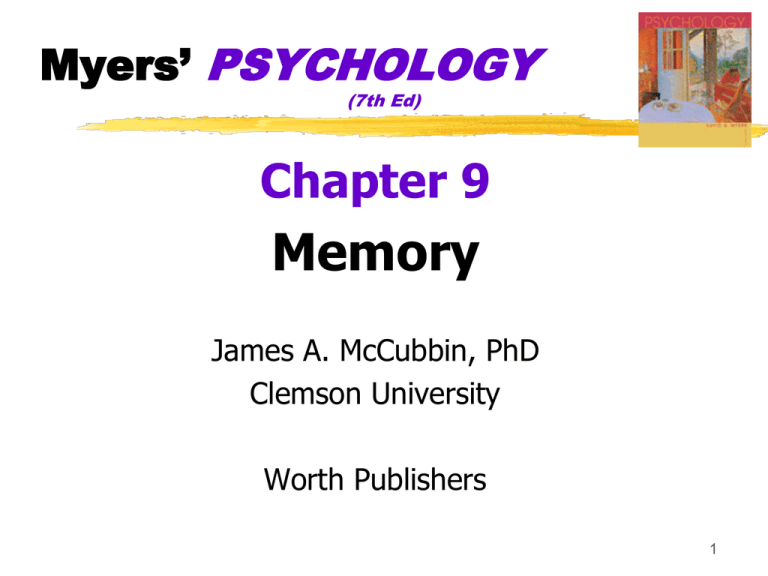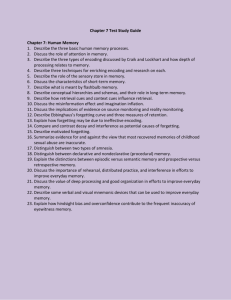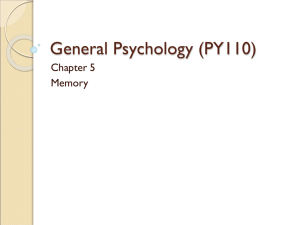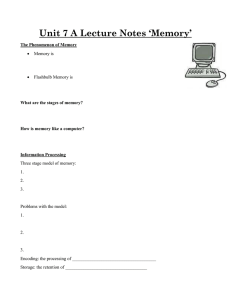Memory
advertisement

Myers’ PSYCHOLOGY (7th Ed) Chapter 9 Memory James A. McCubbin, PhD Clemson University Worth Publishers 1 Which is a penny 2 Memory: Persistence of learning over time using 3 pillars of memory: 1. Encoding 2. Storage 3. Retrieval of info Flashbulb Memory: Where were you when…? a clear memory of an intense emotional moment or event Pictures, others’ retelling, etc., can affect so “remember” things we didn’t really experience Memory as Information Processing How it is similar to a computer: 1. write to file (encoding) 2. save to disk (storage) 3. read from disk (retrieve) 3 1 way it is NOT similar: We___ process…computers ___ process Encoding: placing info into memory systems i.e., extracting meaning (comprehend it so can process…) EX: New word suddenly appears everywhere? Storage retention of encoded info over time… putting it into neural networks…making connections, etc. Retrieval: accessing the info: process of getting info out of memory 4 Memory: 4 different types: Sensory Memory immediate, 1st recording of sensory info in memory systems In bits, quick…& most NOT stored EX: ppl walking down the hallway…do you see all of them? Hear all? Or just “flashes”? What do you keep (retain)? Short-Term Memory (STM) activated memory that holds a few items briefly look up a phone #, then quickly dial b4 the info is forgotten 5 Memory: 4 types continued… Working Memory Newer term…extension of STM processing of briefly stored info: What’s on your “desktop” at a given moment to work w/ What about working on a paper/essay? Longer time on “desk-top” : beginning to make connections to enable storage Long-Term Memory (LTM) the relatively permanent & limitless storehouse of the memory system 6 A Simplified Memory Model: Where would working memory fit in here? Sensory input Attention to important or novel information Encoding External events Sensory memory Short-term memory Encoding Long-term memory Retrieving 7 Encoding: Getting Info In: 1. Effortful: rehearsing to try to 2 ways encode… EX’s? 2. Automatic: just sorta’ happens that we recall EX’s? EBBINGHAUS: study of memory Encoding Effortful Automatic 8 Encoding Automatic Processing unconscious encoding of incidental info Space Time Frequency Daily events well-learned info: hard to shut off word meanings…someone calls you a name? Using effortful, we can change it into automatic processing Ex: reading backwards: do it enough, begins to be automatic; typing 9 Effortful (putting effort into it) Processing requires attention & conscious effort… …& often requires… Rehearsal conscious repetition of information to maintain it in consciousness to encode it for storage Over-learning: Even after have learned it, still practice & rehearse = v. good retention …know it backwards & forwards… 10 Ebbinghaus (348): used nonsense syllables TUV ZOF GEK WAV more times practiced Day 1, the less repetitions to relearn on Day 2…i.e., amt. remembered depends on amt. of time spent learning Found nonsense syllables less effective in remembering than meaningful info WHY? connections in networks Created “forgetting curve” (retention curve) Spacing Effect: distributed practice gives better long- term retention than massed i.e., shorter but more frequent sessions = better learning than long, cramming sessions! *This is a VERY important piece of info 4 U 11!!!! Encoding: Ebbinghaus’s retention curve Time in minutes taken to relearn list on day 2 20 15 10 5 0 8 16 24 32 42 53 Number of repetitions of list on day 1 64 12 Encoding: Serial Position Effect (Place in a series…) How could you use this info? Percent age of words recalled Tendency to recall best the last items & the first items in a list 90 80 70 60 50 Those in the middle tend to blend (or blur) 40 30 20 together…ALSO.. 10 0 Serial Position Effect: 1 2 3 4 5 6 7 8 Position of word in list 9 10 11 12 *Availability *Frequency13 What We Encode: 3 types: 1. Semantic Encoding encoding of meaning including meaning of words + how it relates to other things Tends to create deeper levels of processing 2. Acoustic Encoding encoding of sound, especially sound of words EX: Rhymes easily remembered (“If the glove don’t fit…!”) 3. Visual Encoding encoding of picture images 14 Creates more shallow processing Encoding: See p. 350: Sample ?’s: Visual often = shallow processing But semantic tends to be deeper processing 15 Imagery: “A picture is worth…” Mental pictures: seeing w/ words Can be powerful aid to effortful processing, especially when combined with semantic encoding “wreck” vs. “crash”? Creating visual images in your head, not w/ real pics Mnemonics: “stupid memory tricks…” Greek, Mnemos (goddess of memory) memory aids, espec. techniques using vivid imagery & organizational devices Names of the Great Lakes? Planets? In 10 seconds, memorize the #’s next SL 16 Take 10 seconds to memorize this series of #’s 1812 1492 1941 1776 17 Method of Loci: Chunking: a type of Mnemonic organizing items into familiar, manageable units Like horizontal organization We often do this automatically Phone #’s or SSN’s: Not 8645551212 but 864-555-12 12 use of acronyms: word or sentences to remember EX: HOMES: Huron, Ontar., Michig., Erie, Superi. Colors of the rainbow in order of wavelengths? Planets? Which is easier to remember? 18 4 8 3 7 9 2 5 1 6 OR 483 792 516 Encoding: Chunking Organized info is more easily recalled 2 better than 1… 4 better than 3, etc. 19 Hierarchies: Categorizing related items Listed items remembered better in categories -poorer recall if randomly Even if list is random, ppl still organize info into some logical pattern *Break complex info down into broad concepts & subdivide more into categories & subcategories Encoding (automatic or effortful) Meaning (semantic Encoding) Imagery (visual Encoding) Chunks Organization 20 Hierarchies Storage: Retaining Info Iconic Memory momentary sensory memory of visual stimuli…EX? photographic or pic. image memory lasting few tenths of a second Echoic Memory momentary sensory memory of auditory stimuli 21 Storage: Short-Term Memory Percentage who recalled 90 consonants 80 STM: limited in duration & capacity “Magical” 70 60 50 40 30 number: 20 10 0 3 6 9 12 15 18 Time in seconds between presentation of contestants and recall request (no rehearsal allowed) 7 (+/-) 2 (5 or 6 7 8 or 9) 22 Storage: Long-Term Memory How storage works: Karl Lashley (1950): cut out part of rats’ brains 1. rats learn maze 2. lesion in cortex 3. test memory **Synaptic changes Long-term Potentiation (remember action potentials??) increase in synapse’s firing potential after brief, rapid stimulation Strong emotions = stronger memories some stress hormones boost learning & retention 23 Long-Term Memory (LTM) Amnesia--the loss of memory Explicit Memory (aka “declarative”) memory of facts & experiences we can consciously know & declare hippocampus--neural center in limbic system that helps process explicit memories for storage Implicit Memory (aka procedural): retention independent of conscious recollection EX: a skill…typing 24 LTM Subsystems (B. p. 359): (Chart = EX of what mnemonic??) Types of long-term memories Explicit (declarative) With conscious recall Facts-general knowledge (“semantic memory”) Personally experienced events (“episodic memory”) Implicit (nondeclarative or procedural) W/o conscious recall Skills-motor & cognitive Dispositionsclassical & operant conditioning 25 effects LTM Storage: MRI scan of hippocampus (in red) Hippocampus = brain area that converts info from STM & WM into LTM…works in conjunction w/ areas of frontal lobe Hippocampus, just like hemispheres, is lateralized (left & right side w/ differ. functions for each) Hippocampus 26 Various categories of memory 27 Another memory model including the “Central Executive” 28 Retrieval: Getting Information Out (Use EX’s for each!) (R = 3 R’s + a P!) Recall measure of memory in which the person must retrieve info learned earlier EX’s? Recognition Measure of memory in which the person has only to ID items previously learned EX’s? Relearning: Looking at how much time saved when learning material 2nd time EX’s? Priming: using cues (or clues) to activate, often unconsciously, particular associations in memory… i.e., connections to networks… EX’s? 29 Retrieval Cues (X) Percentage of words recalled 40 30 20 10 0 Water/ land Land/ water Different contexts for hearing & recall Water/ water Land/ land Same contexts for 30 hearing & recall Deja Vu (French: already seen) cues from current situation may subconsciously trigger retrieval of earlier similar experience "I've experienced this before.“ However, ppl resist believing this answer… b/c = “it’s so real!” Mood-congruent Memory: We recall experiences consistent w/ our current mood memory, emotion, & moods become retrieval cues -sad? remember things you felt when sad b4 -angry? recall memories when last angry State-dependent Memory: What’s learned in one state [condition] (like high, drunk, or depressed) is remembered more easily later in same situation EX: If practice on field rather than gym, will remember new skill better --SAT at GHS? 31 State Dependent Learning: After learning to move a mobile by kicking, learning reactivated most strongly when retested in the same rather than a different context EX: If we move kid to playpen, less likely to show this activity as quickly. 32 State Dependent Learning…? 33 7 Sins of memory: Ways memory fails us (365-6): a) 3 of forgetting: 1. Absent-mindedness: inattention 2. Transience: unused fades 3. Blocking: interference…tip-of-the-tongue b) 3 of distortion: We mislead selves or others mislead 1. Misattribution: confusing the source 2. Suggestibility: effects of mis-info (false mem.) 3. Bias: pre-conceived ideas control mem. c) 1 of intrusion: Persistence: unwanted mem.’s are just not “filed” (motivated forgetting) 34 Forgetting: (365) 1. Encoding failure 2. Storage decay 3. Retrieval failure 1. Forgetting as encoding failure: Info doesn’t go to LTM b/c of inattention…or bias…or misattribution, etc. EX: Which is the Penny? 2… Storage decay: Use it or loose it… EX: foreign lang. use? 3… Retrieval failure (368) Can’t retrieve info from LTM b/c of blocking, interference, etc. Motivated Forgetting (370) ppl unknowingly revise memories b/c it is what you would rather believe (denial?) Repression: Freud’s term for “defense mechanism” that removes from consciousness upsetting thoughts, feelings, & memories 35 Attention External events Sensory memory Encoding Encoding Short-term & working Memory Long-term Retrieval memory Retrieval failure leads to forgetting Attention External events Sensory memory Encoding Short- Encoding term memory Longterm memory OR Encoding failure leads to forgetting 36 Forgetting % of list retained when relearning Ebbinghaus’ forgetting curve over 30 days– Initially rapid, then levels off with time 60 50 40 30 20 10 0 12345 10 15 20 25 30 Time in days since learning list 37 Forgetting The forgetting curve for Spanish learned in school % of original Vocab. retained 100% 90 80 70 Retention drops, 60 then levels off 50 40 30 20 10 0 1 3 5 9½ 14½ 25 35½ 49½ 38 Time in yrs after completion of Spanish course Forgetting as Interference (369) Learning some items may disrupt retrieval of other info Can go 1 of 2 ways… 1) Proactive (forward acting) Interference disruptive effect of prior learning on recall of new information…old interrupts ne EX: Knew Judy…meet Julie… …keep calling her Judy 2) Retroactive (backwards acting) Interference Learning new info interrupts recall of old EX: Knew Judy…meet Julie… but now if you see Judy, you call her Julie 39 Forgetting as Interference 2nd example: Learn French…then Spanish 40 Forgetting: Going for a walk or sleeping can limit retro interference -new info makes old info hard to retrieve Retroactive Interference Percentage of syllables recalled 90% Without interfering events, recall is better 80 After sleep 70 60 50 40 30 20 10 After remaining awake 0 1 2 3 4 5 6 7 Hours elapsed after learning syllables 8 41 Positive transfer: Opposite of interference …b/c old info can often HELP (or facilitate) remembering EX: Latin helps us learn French…or advanced English words ----------------------------------------------------- Why might advertisers NOT want to advertise during violent TV shows? (b-369) 42 Forgetting Forgetting can occur at any memory stage As we process info, we filter, alter, or lose much of it Meta-cognition: what we know about what we know or can remember…Most ppl. over-estimate ability in this!! 43 Memory Construction We filter info & fill in missing pieces Misinformation Effect: incorporating misleading info into our memory of an event (wreck/crash?) Source Amnesia (misattribution): attributing to the wrong source an event that we experienced, heard about, read about, …or even imagined Eyewitness testimony Eyewitnesses reconstruct memories when questioned …..?’s can affect mem. E-W memory CAN be unreliable Emotion can affect EX: Priest & Gentleman Bank Robber? “Evil Salsa man?” 44 Eyewitness testimony? “…When they hit =14%” “…When they smashed = __?_%” Depiction of actual accident Leading question: “About how fast were the cars going when they smashed into each other?” Memory construction 45 2 Types of amnesia: A) Retrograde: Forget your past: Who am I? Where am I from? B) Anterograde: Forget the present …can’t form new memories: No STM gets to LTM Damage to what part of limbic system? 46 Memory Construction Memories of Abuse Repressed or Constructed? Child sexual abuse does occur Some adults do actually forget such episodes “repressed” = Freud’s term for it…aka “blocked” False Memory Syndrome Condition where a person’s identity & relationships center around a false but strongly believed memory of traumatic experience Sometimes induced by well-meaning therapists Guidelines are now set to try to stop or limit these 47 Memory Construction: Mem. of abuse: RE: the ? of recovered (repressed) memories: Injustice happens…. Incest happens Forgetting happens Recovered memories are commonplace Unpleasant memories…false OR real…are upsetting But most ppl. (& psy.) do agree on the following: Memories recovered under hypnosis or drugs are especially unreliable …meaning they must be looked at carefully Memories of things happening b4 age 3 are 48 unreliable 9 Ways to Improve Your Memory 1. Study repeatedly to boost recall 2. Make material personally meaningful (relate to things you already know) 3. Activate retrieval cues--mentally recreate situation & mood 4. Recall events while they are fresh-- before you encounter misinformation 5. Minimize interference 6. Use mnemonic devices a) associate w/ “peg” words—something you’ve already stored b) make up story about the info…or tell someone about the info c) Use chunking & acronyms 49 7. Spend more time rehearsing or actively thinking about the material… 8. Take a break! 9. Test your own knowledge rehearse determine what you do not yet know And be sure to Use Elaboration: Ways… -Actively question new information -Think about its implications -Relate information to things you already know -Generate your own examples of concepts -Don’t just highlight passage as you read -Focus on the main or big ideas in the text -Organize these ideas hierarchically ? Activity NEXT…. STOP! 50 Point 1: Thalamus: Should describe the role of the thalamus in the process, specifically that the neural message from the retina first passes through the thalamus, and that the thalamus routes the impulse elsewhere in the brain. Point 2: Retina: Should explain that the light that passes through the pupil, eventually reflected on the pupil, activating neurons in the retina. May use the terms rods and/or cones to describe these neurons, but they do not have to use these specific terms to earn this point. 51 Point 3: Pupil: Should describe how light reflects off the object, and some of the light passes thru pupil into the eye. Point 4: Transduction: Should explain that light waves that were reflected off object are changed into neural impulses (transduction) at the point of the retina, where neurons fire in response to light waves. Again, may use the terms rods and/or cones to describe these neurons, but they do not have to use these specific terms to earn this point. Point 5: Action potential: Should explain that action potentials are released when neurons fire, sending an electrical charge thru the neuron. Students can go on to explain this process in more detail (describing the role of neural structures such as dendrites & the axon) but they nt have to explain those details to earn the point. 52 Point 6: Feature detector: Should discuss the role of feature detectors in their visual perception. Should mention it comes from the thalamus, which routed the neural impulse to the feature detectors, and these groups of neurons organize the neural firings into a conscious visual perception of the object. Students can identify the specific location of the feature detectors (visual cortex in the occipital lobe), but they do not have to provide this detail to earn the point. 53 CH 8/9 FRQ’s Continuous: (Define!) When someone gives one response, they get something each time. An example would be putting $1 into a drink machine and getting a drink out (a reinforcer). But if you give the required response and do not get the reinforcer, then you quit immediately giving the response. Fixed: In this situation, you give a specific number of responses will take you longer to consistently give desired response, but if reinforcer does not come subject is more likely to keep giving the response at least for awhile. 54 List 1: 12 Night Bed Sheets Snooze Alarm Avocado x Nap Blanket Light Pillow sleep Pajamas Mattress 55 List 2 creek flow delta meander flood branchX water bridge Rocks branchX fish banks River stream 56 List 3: Thread Pin Thimble Sharp Injectionx Eye Prick Pain Bleed needle Sewing Point Knitting 57









